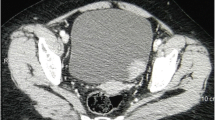Summary
Superficial bladder tumors (Ta, T1, Tis) account for 80% of primary bladder cancers. Transurethral resection and intravesical therapy are successful in controlling the majority of these tumors for up to 5 years. However, patients with multiple or recurrent Ta, T1 and Tis bladder cancer have a lifelong risk of developing stage progression and upper tract tumors. One-half are at risk of having cystectomy eventually and one-third are at risk over a 15-20 year period of dying of bladder cancer.
Similar content being viewed by others
References
Badalament RA, Herr HW, Wong Y, et al (1987) A prospective randomized trial of maintenance versus nonmaintenance intravesical BCG therapy of superficial bladder cancer. J Clin Oncol 5: 441–449
Herr HW (1992) Intravesical BCG: current results, natural history, and implications for chemoprevention. J Cell Biochem 161: 112–119
Herr HW, Laudone VP, Whitmore WF (1987) An overview of intravesical therapy for superficial bladder tumors, J Urol 138: 1363–1368
Herr HW, Badalament RA, Amato DA, et al (1989) Superficial bladder cancer treated with BCG: a multivariate analysis of factors affecting tumor progression. J Urol 141: 22–29
Herr HW, Schwalb DM, Zhang Z-F, et al (1995) Intravesical BCG therapy prevents tumor progression and death from superficial bladder cancer. 10-year followup of a prospective randomized trial. J Clin Oncol 13: 1404–1408
Herr HW, Wartinger DD, Oettgen HF (1992) BCG therapy for superficial bladder cancer: a 10-year followup. J Urol 147: 1020–1023
Herr HW, Cookson MS, Soloway S, et al (1996) The treated natural history of high risk superficial bladder cancer: 15 year outcome. J urol (in press)
Herr HW, Cookson MS, Soloway S (1996) Upper tract tumors in primary bladder tumor patients followed for 15 years. J Urol (in press)
Holmang S, Hedelin H, Anderstrom C, et al (1995) The relationship among multiple recurrences, progression and prognosis of patients with stages Ta and T1 transitional cell cancer of the baldder followed for at least 20 years. J Urol 153: 1823–1827
Kurth K, Turin U, Ay R, et al (1996) Adjuvant chemotherapy of superficial transitional cell bladder carcinoma: long term results of an EORTC randomized trial comparing doxorubicin, ethoglucid and transurethral resection alone. J Urol (in press)
Nadler RB, Catalona WJ, Hudson MA, et al (1994) Durability of the tumor-free response for intravesical BCG therapy. J Urol 152: 367–373
Sarkis AS, Dalbagni G, Cordon-Cardo C, et al (1993) Nuclear overexpresssion of p53 protein in transitional cell bladder carcinoma: a marker of disease progression. J Natl Cancer Inst 85: 53–59
Thompson RA, Campbell EW, Kramer HC, et al (1993) Late invasive recurrence despite long-term surveillance for superficial bladder cancer. J Urol 149: 1010–1014
Author information
Authors and Affiliations
Rights and permissions
About this article
Cite this article
Herr, H.W. Natural history of superficial bladder tumors: 10- to 20-year follow-up of treated patients. World J Urol 15, 84–88 (1997). https://doi.org/10.1007/BF02201977
Issue Date:
DOI: https://doi.org/10.1007/BF02201977




